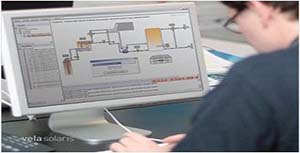All solar collectors, evacuated tubes, flat plate collectors and un-glazed pool heaters have different efficiencies. This is why no one can say Evacuated tubes are always better than flat plate collectors. It depends on their application.
Calculating collector efficiency is complicated and not easy to do without a computer and not all collectors reports will show a graph like the one below.

What this graph above shows is that the greater the temperature difference between the collector temperature (Tm) and the outside ambient temperature (Ta) the less efficient the collector is.
The maximum efficiency in this case is at the X axis = 0 (ie the collectors are just warmer than outside temperature, the maximum Power (W) is 1762. On the right side, at X = 100, the power output drops to about 1180.
However, note that even at high temperature differences the collectors still work well. In the above case, if it is - 40 deg outside and the water is +60 then the collectors still work well.
The slope of the graph shows how good the collector is at retaining heat, i.e how well insulated it is. If it was 100% insulated and lost zero heat the line would be horizontal, and the collectors would work just as well in all conditions. Nothing is insulated 100%, so all collectors will lose heat. The more heat they lose, the steeper the line gets.
Compere the above graph to the one below.

Graph source https://www.phcppros.com/- December 2008
There are a few things to note about this graph.
On the left, the higher the line intercepts the Y axis the better the collector is at capturing sunlight under ideal conditions.
This shows that unglazed pool heating collectors are very good at capturing the sunlight. ie they are black and have no glass to get in the way of the sunlight heating the rubber pool collectors. However look how steep the black line is. Yes they are very efficient when it is warm outside, but as soon as the temperature differential increases (moving right along the graph) the efficiency of then drops like a stone ( a steep black line).
This means they work great at heating your pool water when you live in a hot place or in the summer, but as the temperature difference gets bigger (it gets colder outside) and you have less sunlight then they don't work well at all.
The middle line, the flat plate collectors, are not quite as efficient as the pool collectors but the line is not as steep. They have some insulation in them (the glazing) that helps prevent wind and cold climate stealing heat from the collector.
The white line shows an evacuated tube collector. There are not as efficient as either the rubber pool collectors or the flat plate collectors at low temperatures when it is warm outside, but they are very well insulated so they remain very effective even when the temperatures outside drops to the very cold conditions common in Canada.
The evacuated tubes are not as efficient in summer but this rarely matters in practice. In summer you can leave a black bucket of water in the sun and it will get hot, heating water in Summer is easy, the hard part is heating water when it is cold and cloudy outside, this is where the evacuated tubes work best.
If you have an off grid cabin somewhere in the woods and only use it in the summer, then sure a Flat Plate collector would probably suit your needs. Only now you must ask what is the price of the collector? One of our 30 tube collectors will heat an 80 gallon tank to nearly boiling point just about every day in summer. You need to compare the cost per BTU.
Notice that both the pool and flat plate glazed collectors line both hit the x axis. In practice this shows that they both have a maximum temperature differential at which they will NOT heat water anymore, i.e. they become ZERO efficient.
This is why in the cold and cloudy conditions of Canada in the winter months, you cannot heat a pool with a unglazed rubber solar collector and why the performance of flat plate glazed pool collectors is so poor in the winter months.
OK, I get it now, it means that is I want to heat my home with solar, I need evacuated tubes?
Yes, if you want to heat your house or heat domestic water in winter in Canada when it is - 40 deg C outside then the evacuated tubes work very well. The SRCC test reports show that in cold and cloudy conditions, evacuated tube collectors can produce 1100% (yes 1100%) more heat than the flat plate collectors will. See here for full details.





